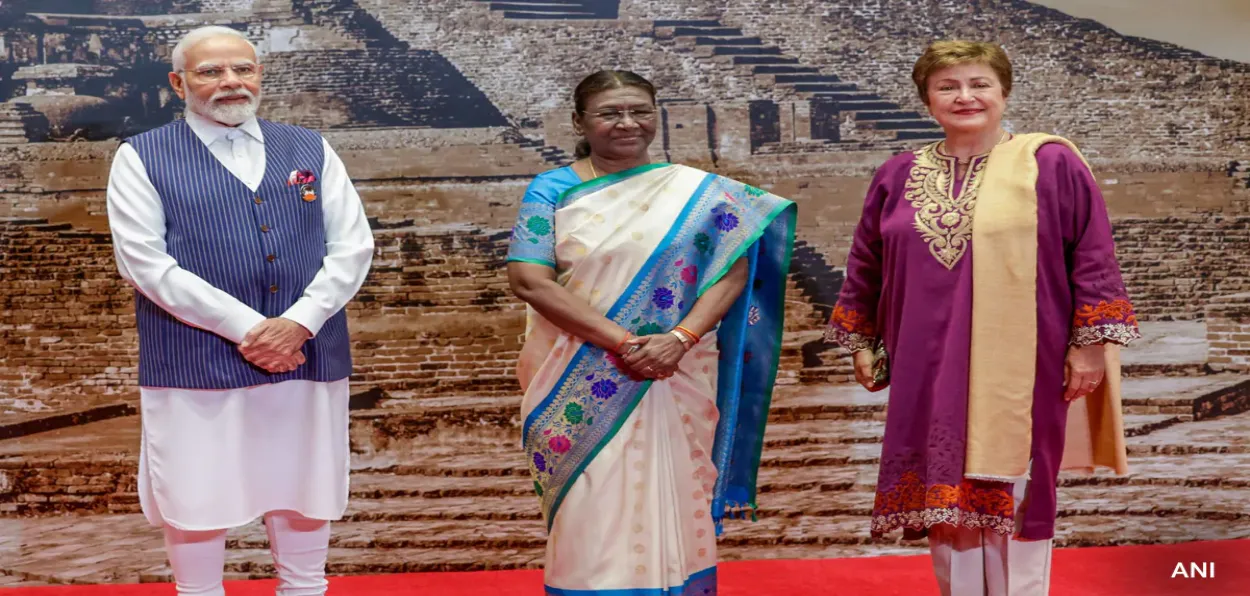
 Sushma Ramachandran
Sushma Ramachandran
The International Monetary Fund has raised India’s growth forecast from 6.4 to 6.6 per cent for the 2025-26 fiscal year while commending its role as a key global growth engine. This is in the backdrop of continuing geopolitical tensions and the advent of protectionism in advanced economies.
The IMF Managing Director, Kristalina Georgieva, has even highlighted India’s bold economic and structural reforms, from revised direct and indirect tax laws to the mass rollout of a digital payments ecosystem and the creation of a digital social identity in the form of Aadhar.
Georgieva, who made these remarks, noted that India’s role as a key growth engine has emerged even as China is decelerating steadily. The multilateral financial institution’s decision to upgrade its forecast indicates that it does not expect the high U.S. tariffs to have a significant impact on economic growth. This has been consistently high in recent times, with the first quarter of the current fiscal recording a buoyant 7.8 per cent rise in GDP.
As for the world economy, Georgieva felt it had generally withstood acute strains from multiple shocks. She maintained that the resilience stemmed from improved policy fundamentals, private sector adaptability, less severe tariff outcomes than initially feared and supportive financial conditions. Regarding emerging economies like India, she felt they had significantly upgraded policy frameworks and institutions.
Despite this relatively bright scenario, India faces several challenges to maintain the growth momentum. The first is the tariff issue, which Georgieva downplayed. There is no doubt that the 50 per cent tariff levied by the U.S. on India’s exports will have negative consequences, given that of the 437 billion dollars worth of total annual goods exports, as much as 86 billion dollars go to the American market. What is worse is that tariffs have been levied on labour-intensive sectors like apparel and leather footwear, as well as gems and jewellery. Many export units have already begun laying off workers and artisans as buyers are not prepared to place orders at such high rates.
The second factor that could upset growth calculations is the continued reliance on China for critical minerals like rare earths. The decisions to set up a critical minerals mission as well as to stockpile rare earths are positive developments, but needed to have been taken much earlier. Import dependence on the northern neighbour is also a reality regarding key pharmaceutical ingredients, as well as some fertilisers. In all these categories, China has recently imposed curbs on imports. For the time being, a diplomatic outreach has averted a crisis in availability. For the long term, however, alternative sources for these products will have to be identified while enhancing domestic production.
At the same time, negative outcomes could well be mitigated by a recent spate of measures taken to combat the impact of U.S. tariffs. This includes the move to rapidly conclude free trade agreements with major export destinations like the U.K. and Europe. The FTA with the European Free Trade Area (EFTA) may be confined to only four countries, but these are advanced economies with the capability to absorb both industrial and farm exports from this country in large volumes. The other pathbreaking element of the pact is the linkage to 100 billion dollars of investments, which can provide a long-term stimulus to the manufacturing sector.
The India-UK FTA is also likely to provide an edge to exporters that had been facing tough competition from China, Indonesia and Vietnam. The concessions, which cover 99 per cent of tariff lines, provide tremendous opportunities in a market that has enormous potential. So far, exports have reached only about 13 billion dollars annually, in contrast to China, which supplies 99 billion dollars worth of goods. As for the trade pact with the European Union, it needs to be sped up as this is an even bigger market than the U.S. Bilateral India-EU trade is 175.5 billion dollars per annum compared to 131.8 billion dollars with the U.S.
The other substantive initiative taken to blunt the impact of weaponised tariffs has been the rationalisation of the Goods and Services Tax. The impact is already being felt in the festival season as e-commerce platforms are witnessing record sales of products across the spectrum. This could be the initial response to cheaper goods following the tax cuts, so a better assessment will be possible only by December. Even so, it seems evident that the gamble to lose revenues up to Rs. 48000 crore this year due to the tax changes is likely to pay off in terms of higher consumption. This should, in turn, spark off a virtuous cycle of higher investment and bring about the much-needed animal spirits to the economy.
ALSO READ: Was the two-nation theory brainchild of Sir Syed Ahmad Khan?
This is a stimulus that is needed right now. While India may be described as the global growth engine by the IMF chief, a 6.5 percent growth rate is not sufficient to achieve the aim of becoming a developed economy by 2047. It needs to step up growth to eight or nine per cent annually to avoid falling into what is known as the middle-income trap. This is a scenario in which a country is unable to transition to a higher per capita income level. Thus, India may be more resilient and capable of tackling external headwinds than many other countries, but high growth must be sustained over the medium and long term. Only then will it be possible to reach the goal of becoming Viksit Bharat in the coming decades.
